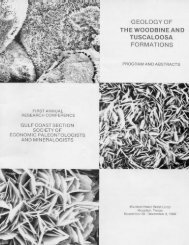Program and Abstracts - Gulf Coast Section SEPM
Program and Abstracts - Gulf Coast Section SEPM
Program and Abstracts - Gulf Coast Section SEPM
Create successful ePaper yourself
Turn your PDF publications into a flip-book with our unique Google optimized e-Paper software.
A Robust <strong>and</strong> Compute-Efficient Variant of the Radon Transform<br />
Aarre, Victor<br />
Wallet, Bradley<br />
Schlumberger Information Solutions<br />
P.O. Box 8013<br />
N-4068 Stavanger<br />
Norway<br />
In 2003 AlBinHassan <strong>and</strong> Marfurt explained that<br />
the Hough transform can be used to detect fault lines in<br />
2D seismic data. Their conclusion was t hat “The<br />
Hough Transforms method is a good c<strong>and</strong>idate for<br />
enhancing lineaments associated with fractures <strong>and</strong><br />
faults.” But, they also observe that “the problem with<br />
the running window code is that the new code will be<br />
more sensitive to noise such that the image may not be<br />
as clear as we wish.” Another problematic issue with<br />
the windowed Hough transform, though not discussed<br />
in the AlBinHassan’s paper, is that the run-time is not<br />
very favorable for long operators (i.e., long line segments).<br />
In general, if an image contain m*n pixels, <strong>and</strong><br />
we search for line segments of length k, the runtime<br />
complexity will be in the order of m*n*k*k computational<br />
units. In practice, this means that if we double<br />
the scan line length, the run-time will be four times as<br />
long. Clearly, if we look for very long fault lines for<br />
every 2D section in a 3D seismic attribute volume, runtime<br />
will be an issue. The Hough transform is generally<br />
Abstract<br />
known to be very similar to the Radon transform (it can<br />
be convincingly argued they are equivalent), which in<br />
turn is closely related to the Fourier transform, so any<br />
issues observed with the Hough transform will have the<br />
same issues in a Radon- or Fourier-based approach,<br />
although Fourier can sometimes be more computationally<br />
efficient through the use of the FFT. We have over<br />
the last year tried to overcome these two problems for<br />
the windowed Hough tr ansform. Specifically, by<br />
improving the transform slightly <strong>and</strong> by calculating<br />
varying properties along the scanned line segments, we<br />
manage to make the approach more robust in the presence<br />
of r<strong>and</strong>om noise. We have also found a twist to the<br />
algorithm which makes the run-time linearly rather<br />
than fourth-power dependent on the line segment<br />
length, giving rise to an algorithm that can be applied<br />
to large seismic 3D volumes. In this paper, we present<br />
some of the theoretical details of how these two issues<br />
are solved, <strong>and</strong> also demonstrate the results on a 3D<br />
seismic dataset.<br />
Attributes: New Views on Seismic Imaging—Their Use in Exploration <strong>and</strong> Production 23
















